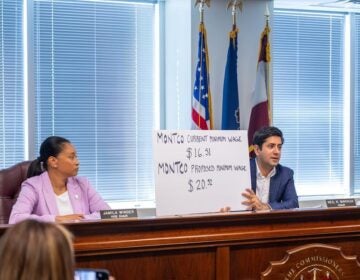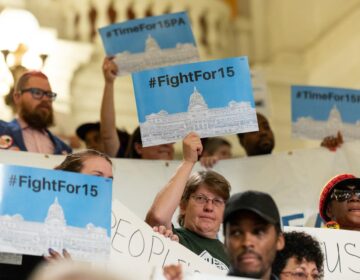Why and how 11 Trump states raised the minimum wage, explained
Here’s a look at the path to minimum wage increases in other reddish states.

Arizona State Elections Director Eric Spencer, middle, helps Arizona Healthy Working Families Initiative group members deliver more than 270,000 signatures to the elections office at the Arizona Capitol, Thursday, July 7, 2016, in Phoenix, in hopes of qualifying a measure for the November ballot to raise the state's minimum wage to $12 an hour by 2020 and provide earned sick days to workers. (Ross D. Franklin/AP Photo)
This story originally appeared on PA Post.
—
Across the country, 29 states have raised the minimum wage above the federal level.
Some of those states are solidly Democratic or lean toward Democrats. Think New York, Hawaii, most of New England, and all of the states on the West Coast.
But there are multiple Republican-leaning areas that have raised the minimum wage.
Of the 30 states that Republican Donald Trump won in 2016, more than a third have a minimum wage above the federal level.
But most of the time, when those 11 reddish states raised the minimum wage, the measures passed through a ballot referendum. Often, those referendum questions passed without much formal opposition.
In Nebraska, for instance, voters in 2014 had the option of approving a gradual minimum wage increase to $9 an hour.
Leaders with the Nebraska Chamber of Commerce and Industry looked at what happened in other states and didn’t think they had much of chance of winning if they fought the ballot initiative.
“We stood down,” Ron Sedlacek, vice president and general counsel for the Nebraska chamber.
There are two exceptions to the referendum route in the Trump states:
- West Virginia, which has tilted toward Republicans in presidential elections, still had a Democratically-controlled Legislature and a Democratic governor in 2014 when its minimum wage increase passed.
- Republican-led legislatures in Michigan voted to raise the minimum wage in 2014 and again in 2018. But both times, they faced a voter referendum that could have raised the minimum wage even higher.
In Pennsylvania, Democratic Gov. Tom Wolf has called for raising the state’s minimum wage, which is the same as the federal rate of $7.25 per hour. Wolf wants a rate of $12 per hour this year and $15 per hour by 2025.
Republican leaders who control the General Assembly have indicated they are open to discussing an increase, although they’ve raised concerns about Wolf’s proposal.
In Pennsylvania, voters can’t use a statewide ballot referendum to go around the Legislature.
Across the country, 24 states have an initiative process that allows voters to place questions on the ballot, according to the National Conference of State Legislatures.
But, in Pennsylvania, the state Senate and House have to pass legislation authorizing any statewide question.
Here’s a look at the path to minimum wage increases in other reddish states. (The below minimum wage rates are as of March 29, 2019, and they refer to the general minimum wage rates — some states grant exceptions for certain categories, such as for tipped workers.)
Florida
How it votes in presidential elections: It’s historically a battleground state — as you might recall from the 2000 Florida recount. It has gone with the winner in every presidential election from 1996 on.
What the minimum wage is now: $8.46 per hour
How the minimum wage rose:
In November 2004, voters approved a constitutional amendment to raise the minimum wage to $6.15 an hour and link increases to inflation.
Montana
How it votes in presidential elections: The last Democrat to win the state was Bill Clinton in 1992.
What the minimum wage is now: $8.50 per hour.
How the minimum wage rose: A voter referendum passed in 2006 that raised the wage to $6.15 an hour and linked increases to inflation.
Ohio
How it votes in presidential elections: It’s been considered a battleground. It has gone with the winner of the presidential election from 1964 on.
What the minimum wage is now: $8.55
How the minimum wage rose:
In November of 2006, Ohio voters approved a constitutional amendment that raised the state’s minimum wage from $5.15 per hour to $6.85 per hour. It also tied annual increases to the rate of inflation.
That has led to increases regardless of who’s controlling the Legislature and governor’s office.
The rate increased to $8.55 at the start of this year.
Michael Shields worked as a canvasser and field manager on the 2006 campaign to pass the ballot measure. Now he is a researcher with Policy Matters Ohio.
He argues the minimum wage is still too low. But he said the inflation component is an important safeguard.
“This the thing: You know, nobody votes to decrease the minimum wage, right? But because of inflation, if you just neglect it, then it decreases automatically in real terms,” Shields said.
Missouri
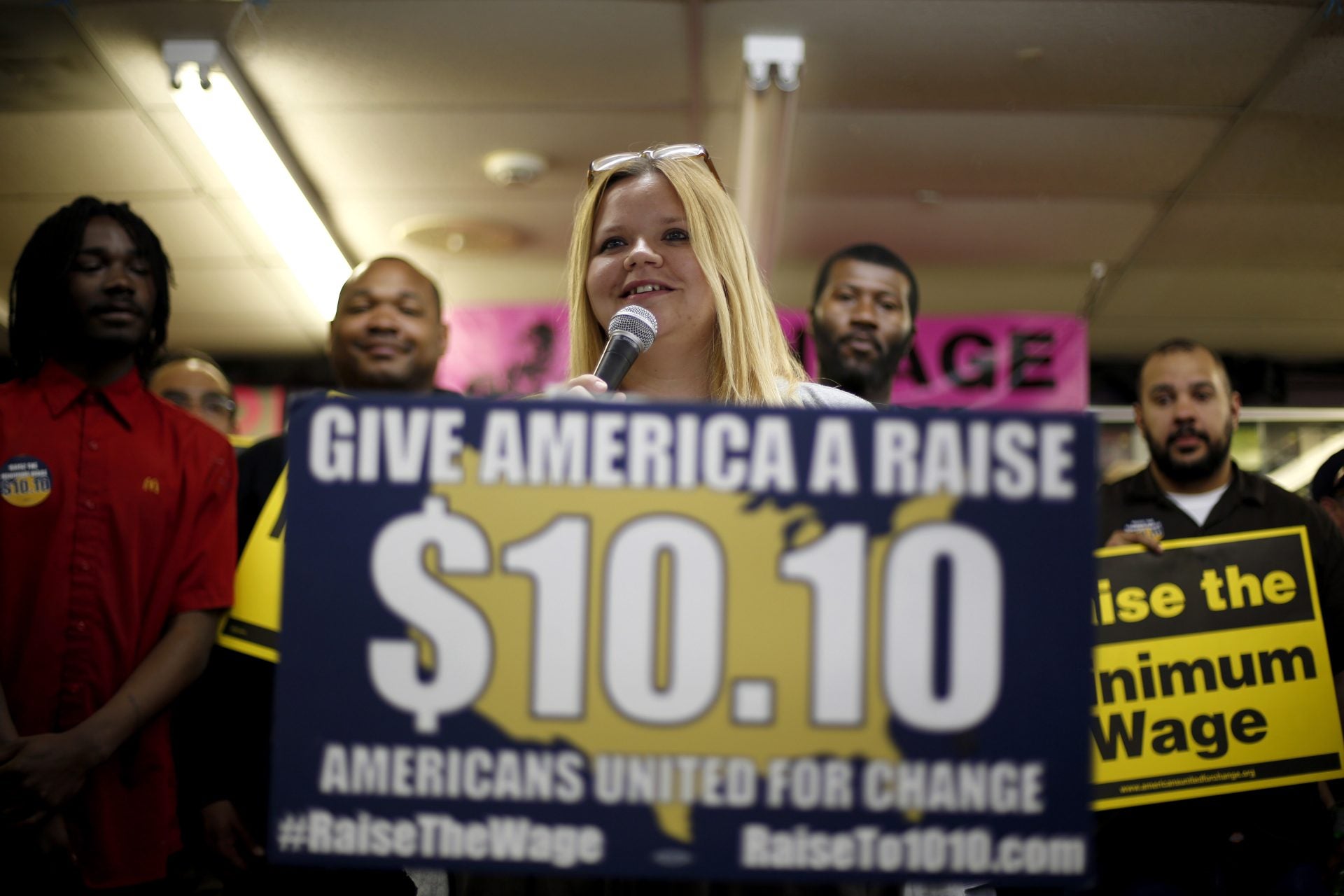
How it votes in presidential elections: It used to be a considered a bellwether state, but it has been shifting toward Republicans. Bill Clinton won the state in 1992 and 1996, but no Democratic presidential candidate has done so since then.
What the minimum wage is now: $8.60 per hour.
How the minimum wage rose:
In 2006, Missouri voters approved a minimum wage increase through a referendum and tied increases to inflation.
In a November 2018 referendum, voters went further and approved a gradual minimum wage increase. The rate increased from $7.85 per hour to $8.60 per hour at the beginning of the year, and it will rise to $12 per hour in 2023.
The Springfield News-Leader reported that Missouri Gov. Mike Parson, a Republican, didn’t support the increase. But after the referendum, he said, “The people of Missouri have spoken. We will continue to move forward by growing Missouri’s workforce.”
Ahead of the election, the vice president of the Missouri Chamber of Commerce said his organization was more focused on passing a measure to raise Missouri’s gas tax in order to fund infrastructure, according to St. Louis Public Radio. The gas tax measure failed.
West Virginia
How it votes in presidential elections: The last Democrat to win was Bill Clinton in 1992 and 1996. In 2016, Donald Trump won about 68 percent of the vote.
What the minimum wage is now: $8.75 per hour.
How the minimum wage rose: While the state started trending toward Republicans in presidential elections in 2000, the shift in state politics was slower.
In the spring of 2014, Gov. Earl Ray Tomblin signed a gradual minimum wage increase. Tomblin was a Democrat, and his party also controlled the state Legislature.
The measure received bipartisan support. But Ted Boettner, a supporter of raising the minimum wage and executive director of the West Virginia Center on Budget and Policy, said that without Democrats controlling the Legislature and pushing a vote, the increase “almost definitely would not have happened.”
Republicans now control the Legislature and the governor’s office. Getting a minimum wage increase on the agenda today “would be a very difficult lift,” Boettner said.
Nebraska
How it votes in presidential elections: The last Democrat to win the state was Lyndon Johnson in 1964.
What the minimum wage is now: $9 per hour.
How the minimum wage rose:
In November 2014, Nebraska voters approved a gradual minimum wage increase, first to $8 an hour in 2015. and then to $9 an hour in 2016.
Danielle Conrad, a former state senator in Nebraska, was the campaign manager for the committee that pushed for the minimum wage increase. The committee raised more than $1 million, according to the Omaha World-Herald.
While the Republican governor said he planned to vote against the ballot measure, Conrad said the organized opposition was “pretty modest.”
“They were looking at the same polling that we were, which demonstrated very strong support,” Conrad said, later adding that the proposal was a “common-sense and kind of measured increase.”
A key part of the Nebraska campaign was focusing on the gender disparity in the minimum wage. Conrad said at the time of the campaign, seven in 10 Nebraska workers who earned the minimum wage were women.
South Dakota
How it votes in presidential elections: The last Democrat to win the state was Lyndon Johnson in 1964.
What the minimum wage is now: $9.10 an hour
How the minimum wage rose:
In 2014, South Dakota voters approved a minimum wage increase to $8.50 per hour. The measure also tied the minimum wage to inflation increases.
Deb Knecht was the head of the South Dakota Democratic Party at the time.
Knecht said supporters of the measure conducted a poll and found 60 percent of respondents supported an increase. She and other others supporters started out talking about an increase to $10 per hour, but they decided to drop the increase down to $8.50 per hour.
The party and labor unions led the effort and collected more than 25,000 signatures to get the question on the ballot.
Supporters raised about $85,000 for the campaign to raise the minimum wage — and ended up spending less than that: about $52,000, Knecht said.
The measure passed.
“It wasn’t as hard as we thought it was going to be,” Knecht said. “It was really pretty easy.”
The South Dakota Retailers Association opposed the minimum wage increase, saying that tying the rate to inflation was the biggest problem.
But Nathan Sanderson, executive director of the association, said it “certainly didn’t fight this as strenuously as we would — as we have other measures.”
One reason?
Sanderson said employers didn’t want to damage their relationships with employees. He compared the issue to having an argument with a family member.
“Would you prefer to have the argument with your family member, you know, in private or where everybody can hear all the nitty-gritty?” Sanderson said.
In 2016, South Dakota voters rejected a referendum that called for decreasing the minimum wage for workers under 18.
Knecht said there are a lot of voters in South Dakota who agree with Democrats on economic issues. But social issues — abortions mainly, but also guns — keep them voting for Republican candidates.
“They just can’t get past that,” Knecht said.
Arkansas
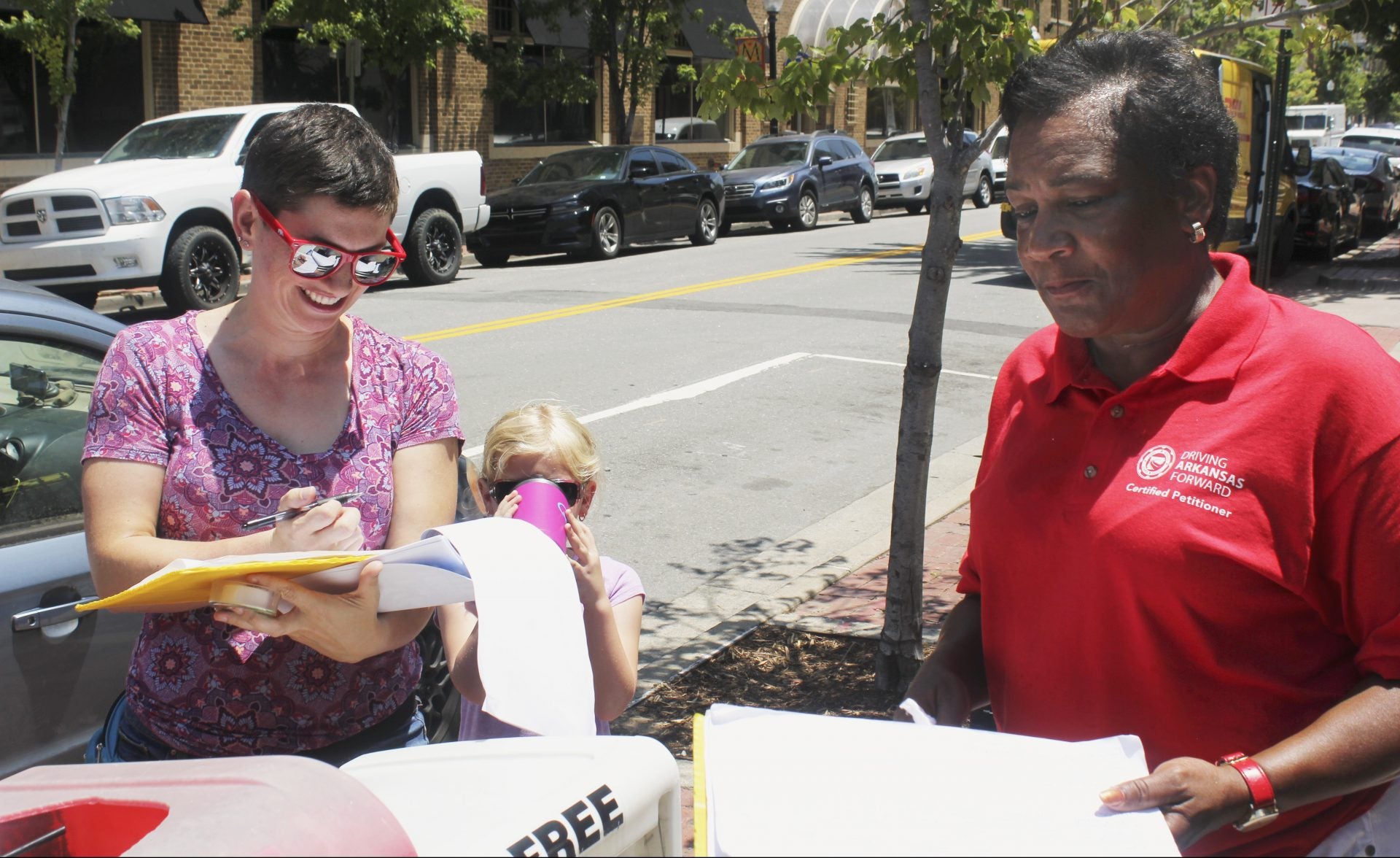
How it votes in presidential elections: Bill Clinton, a former governor of the state, is the last Democratic presidential candidate to win there. He won in both 1992 and 1996.
What the minimum wage is now: $9.25 an hour.
How the minimum wage rose:
In 2006, Arkansas lawmakers approved a minimum wage increase to $6.25 per hour. At the time, Republican Mike Huckabee was the governor but Democrats controlled both chambers of the Legislature.
The political environment has changed a lot since then, said Rich Huddleston, an advocate for raising the minimum wage and the executive director of Arkansas Advocates for Children and Families.
Republicans now control the Legislature and governor’s office.
In 2014, supporters of raising the minimum wage took the issue to a ballot referendum. Voters approved a gradual increase to $8.50 per hour.
In 2018, minimum wage supporters again turned to a ballot referendum. More than 68 percent of voters favored the referendum, which raised the minimum wage to $9.25 an hour in January.
As part measure, the minimum wage will rise to $11 an hour by 2021.
Some Arkansas lawmakers have tried to amend the voter-approved initiative.
But Republican Gov. Asa Hutchinson has opposed those efforts, recently saying, “the people have spoken.”
The rate is not tied to inflation. So while Huddleston thinks it will be a “huge help” to families for at least a couple of years, eventually he would like to see the rate increase again.
And he doesn’t expect that increase to go through the Legislature.
“At this stage, unless the political environment changes dramatically in Arkansas, I would anticipate that would have to be through the ballot measure process,” Huddleston said.
Michigan
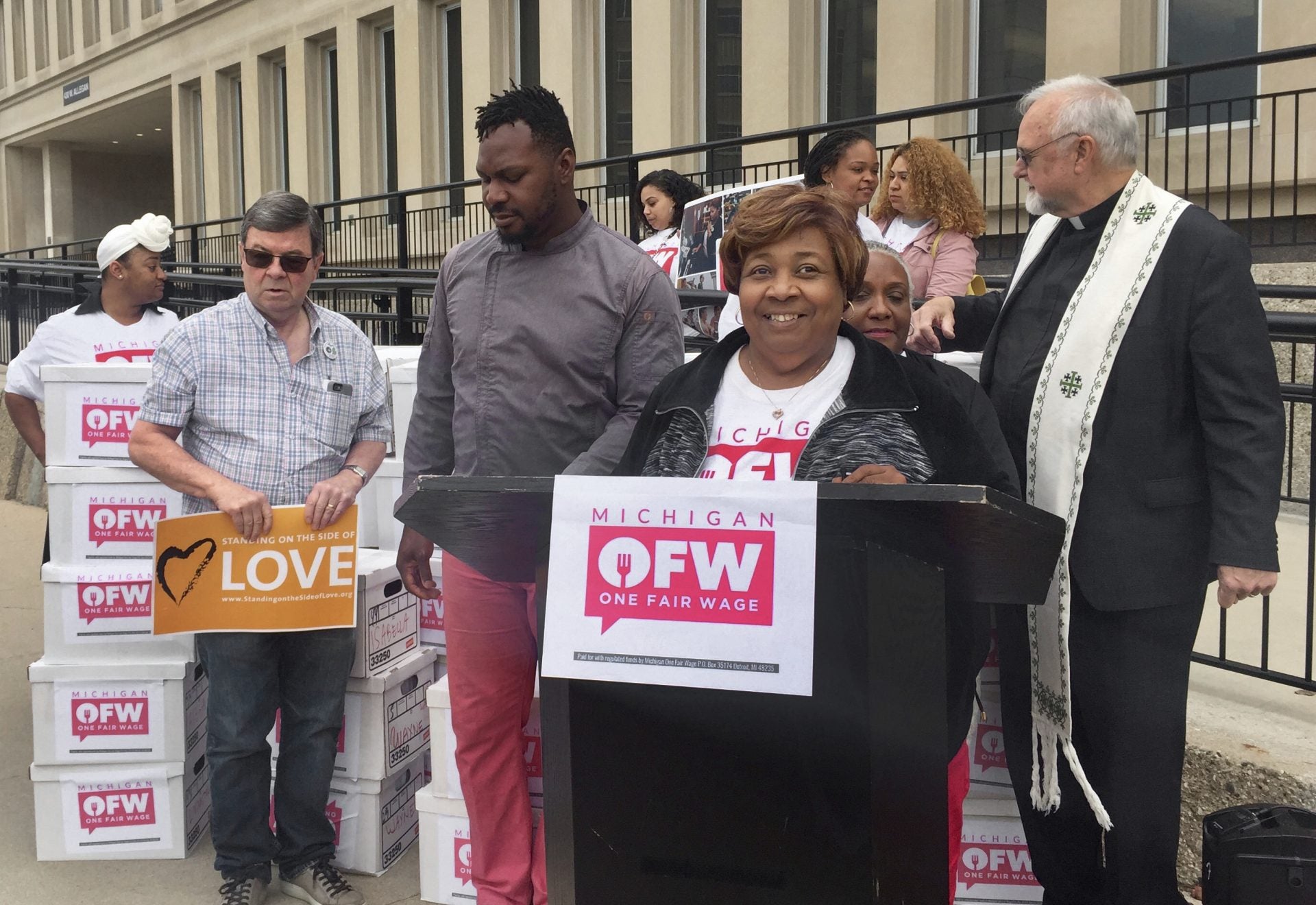
How it votes in presidential elections: It’s a battleground that has leaned toward Democrats in recent years. Before Trump, Democratic presidential candidates had won Michigan in six elections in a row.
What the minimum wage is now: $9.45 an hour.
How the minimum wage rose:
In 2014, Michigan lawmakers approved a gradual increase in the minimum wage to $9.25 by 2018. At the time Republican Rick Snyder was governor and Republicans controlled the Legislature.
But the Michigan Chamber of Commerce said the legislation “was passed to ward off a dangerous ballot proposal that, if adopted by voters in November, would have increased Michigan’s minimum wage to $10.10 per hour.”

Four years later, Republican leaders in Michigan took a similar approach in the face of another ballot referendum — this one, if passed, would have raised the wage to $12 per hour in 2022 with future increases tied to inflation.
Instead, lawmakers passed the proposal that was scheduled to be on the ballot and then amended it. Now, the minimum wage is scheduled to reach $12.05 per hour in 2030 with no inflationary increases after that.
Alaska
How it votes in presidential elections: Since Alaska became a state in 1959, only one Democratic presidential candidate has won there. That was Lyndon Johnson in his 1964 landslide.
What the minimum wage is now: $9.89
How the minimum wage rose: In 2014, nearly 70 percent of voters supported a measure to gradually raise the minimum wage and link its increase to inflation.
Arizona

How it votes in presidential elections: The last Democrat to win the state was Bill Clinton in 1996.
What the minimum wage is now: $11
How the minimum wage rose:
In 2016, voters approved a ballot measure, which calls for increasing the wage to $12 an hour by 2020, according to AZ Central.
WHYY is your source for fact-based, in-depth journalism and information. As a nonprofit organization, we rely on financial support from readers like you. Please give today.


